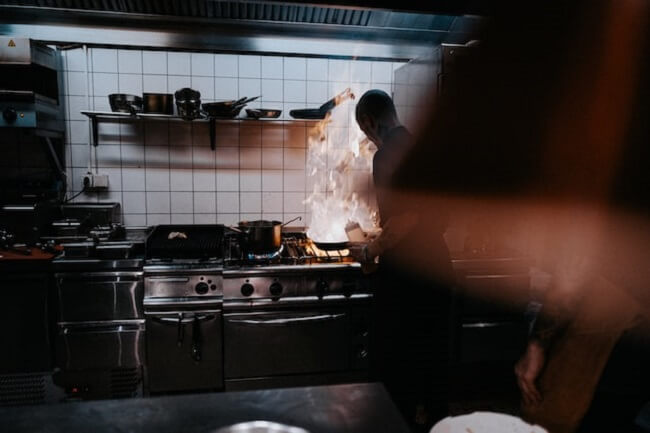Cloud kitchens are centrally licensed commercial food production facilities that lease space from one or two to dozens of restaurants to prepare and deliver optimized menu items. A restaurant can have multiple brands or virtual restaurants all under one roof, or the kitchen can be shared by different suppliers, like an incubator. Imagine a large warehouse with many stainless-steel preparation stations, hoods, stoves, ovens and washing stations (mini restaurants), each with its own orders coming directly from customers.
Cloud Kitchen’s menu items are optimized for food quality reliability in production and delivery. Cloud kitchens, often located in industrial parks outside the city, can offer driver parking spaces, driver waiting areas (often with screens that monitor order time), and check-in stations for hassle-free driver pick-up. All to get food out the door and into the hands of customers as quickly as possible.
Cloud Kitchen has unique technical support. They use ubiquitous smartphone food delivery apps like UberEATS, Grubhub and Doordash. In the process, they use vast amounts of data to determine what types of food to produce for a given community and when demand is likely to be greatest.
As technology advances, additional services are available that combine different delivery applications into a single portal to facilitate multiple order production and delivery coordination, as well as smart food procurement and production software to reduce food waste and improve per-meal economics. We are only seeing the tip of the iceberg of innovation in this area.
What Made Cloud Kitchens So Popular?
Over the years, cloud kitchens have become a popular investment option for established restaurants and new food businesses. Established restaurant chains are also now opening cloud kitchen stores instead of dine-in restaurants to meet large sell-out orders. Online food aggregators, major players in the field, have also experimented with cloud kitchens.
When it comes to cloud kitchen market trends, the numbers speak for themselves. The global cloud kitchen market is valued at approximately USD 57 billion in 2021 and predicted to grow with a CAGR of ~13% During 2022-2030; the market will grow with the popularity of online food delivery services and irregular work schedules.
So, let’s take a look at why the restaurant industry is jumping on the cloud kitchen bandwagon.
1. Market opportunities
Convenient food delivery at reasonable prices and in record time has led to an increase in online orders. People prefer to order food instead of eating out. Online food delivery is not only a market share of traditional eateries but also a replacement for home-cooked food.
Home delivery options have become popular with changing customer preferences and the increasing difficulty of eating out, and with it, the restaurant industry is also changing as food now takes over dining. The average urban working professional places orders online 3-4 times a week, and in some cases, this number can increase to daily orders. Online aggregators are also expanding their business in tier two and tier three cities, further expanding their market size.
2. Less investment
Opening a cloud kitchen requires less investment because you no longer need prime, high-traffic locations, reducing real estate costs. Plus, without a front desk, you don’t need fancy decor and welcoming service staff to ensure a great guest experience. These two factors play a major role in reducing the cost of starting a cloud kitchen business. You can open a cloud kitchen for a third of the investment required to open a traditional restaurant.
3. Easy to experiment with
The cloud kitchen business model allows restaurants to experiment with multiple concepts without large investments. You can serve multiple brands from one kitchen using the same kitchen infrastructure and resources. Creating a new brand is as easy as listing it in an online food aggregator.
Since online food aggregator listings are free and charge a percentage of each order, you only have to spend on order preparation. If the brand is not performing well, you can simply remove the listing from the online food aggregator. In this case, the success or failure of one brand will not affect other brands operating in the same cloud kitchen. Read here how a multi-brand cloud kitchen allows restaurants to try multiple concepts with minimal risk.
4. Easily expand operations
In the case of a cloud kitchen business, scaling operations are faster and easier. Since the investment required to open a cloud kitchen is significantly reduced, you can open multiple cloud kitchens in the same period.
Cloud Kitchen Marketing Strategy and Trends
When it comes to online companies like cloud kitchens, marketing cloud kitchens plays an important role in establishing branding and awareness. In the absence of brick-and-mortar stores, the number of transactions depends largely on online promotions rather than foot traffic. Let’s look at how to market a cloud kitchen business, starting with the basics.
Be active locally with SEO
Increase the visibility of nearby restaurants by signing up for Google My Business. That way, if a user searches for “apple pie near me,” the search engine will automatically select your store based on your recorded GPS location. SEO can have a huge impact on your online traffic with a fixed address. Your online store receives orders via Google search, Maps or Assistant.
Content marketing strategy
Video marketing has taken off with the popularity of TikTok and should be a part of any social media plan for cloud kitchen. Most people find videos more engaging than text-based content. Upload informative videos that capture emotion and promote your cloud kitchen brand.
The power of influencer marketing
Social media has created a strong culture of influencers covering food, cosmetics, clothing and more, and this platform has paved the way for influencer marketing. Use the following and talent of food bloggers to create and publish content for you.
Old-fashioned email and mobile marketing
Connect with traditional markets not available on social media. Sometimes they don’t have your mobile app, or they don’t have access to your website. Connect with these customers and inform them about the services and hospitality you offer via SMS or email.
Exclusive offers and tricks
Run campaigns, special offers and contests on your consumer database. This is how referral marketing works when they order online with friends and family.
How Do You Make a Cloud Kitchen Brand?
With the right budget, the right resources, and the right marketing, the cloud kitchen model will soon be profitable for any cloud kitchen owner.
Here are a few things to consider when it comes to building a cloud kitchen.
1. Choose the right rental location
The location of the cloud kitchen is important mainly based on the demographics of the order and the type of food offered by the cloud kitchen. Cloud kitchen startups are typically deployed based on demand, customer demographics, and the type of food produced by the cloud kitchen.
2. License and trademark registration
Licensing is an important part of any setup as it governs regulatory requirements and keeps your business running smoothly. Obtaining the right licenses frees the cloud kitchen model from all legal hassles and allows customers to understand the high-quality food and sanitation provided by cloud kitchens. Displaying a license or badge on your website can increase customer trust.
3. Decide on the menu
Competition for cloud kitchen startups is very different from traditional kitchen catering. In general, cloud kitchen models are known for the special type of food they offer and the quality of the food. The key factor is deciding what type of main dish to cook. This decision should be based on proper analysis, resource analysis, facilitation of raw material procurement, personnel management, etc.
4. Kitchen space, equipment, and raw materials
The type of equipment required depends on the cuisine offered by the cloud kitchen. A person can save money by equipping the kitchen with proper electronics for preparation and buying a used or used table. If there are several brands under one kitchen, common kitchen equipment (such as chimneys, burners, etc.) can save costs. The cloud kitchen can even be outsourced from the basic equipment and upgraded as needed. When it comes to food and packaging quality, these are the characteristics that customers look for in cloud kitchen startups.
5. Online order management system
Much of the business model of cloud kitchen startups are based on food delivery aggregators. It largely depends on the order quantity, proper tracking and preparation and proper delivery. Imagine having to manually pick up each order from another food aggregator and notify the staff. This can interfere with the smooth operation of your cloud kitchen due to possible errors, lack of correct information, etc.
6. Personnel requirements
Initially, 1-2 chefs are recommended, with 1 person handling billing, phone inquiries, and marketing staff. Cleaning and maintenance of the cloud kitchen require 1-2 people. When profits increase, employees can increase their volume as needed.
7. Marketing
In cloud kitchens, the only limitation is in physical marketing, but these industries are free to use the potential of online marketing. There is no fixed platform that is best for marketing, and it is recommended to implement several marketing methods to find the best platform for discovering the cloud kitchen.
Final Thoughts
Cloud kitchens are disrupting the food industry as foodies increasingly turn to ordering food online and having it delivered to their doorstep. While restaurants have always had a place for dining, cloud kitchens remain a significant contender due to their convenience and variety. Plus, cloud kitchens are here to stay, and social distancing is the new normal post-COVID-19 pandemic. They have started to take over the market and arouse the interest of investors.




